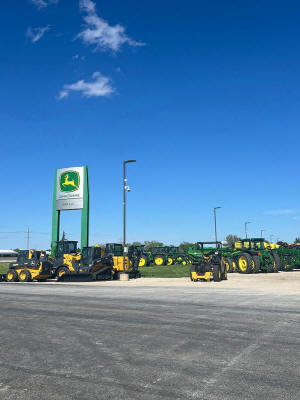Too many tractors: As boom times fade, farm equipment piles up
 Send a link to a friend
Send a link to a friend
 [May 09, 2024] By
Bianca Flowers and Renee Hickman [May 09, 2024] By
Bianca Flowers and Renee Hickman
DEKALB, Illinois (Reuters) - Falling crop prices are leaving agriculture
equipment sellers with an excess of unsold tractors and combines. To
cope with the surplus, dealers are discounting machines, suspending new
orders, and even auctioning off equipment at reduced prices.
The slower equipment sales are a knock-on effect of corn and soy prices
dropping to more than three-year lows as U.S. farm income plummets and
equipment makers and dealers are forced to pivot quickly after a period
of booming business.
Reuters interviewed ten equipment dealers, mostly in the Midwest, as
well as farmers and analysts, who said low crop prices combined with
persistently high interest rates are deterring farmers from purchasing
machinery. As farmers make fewer purchases, inventories of equipment are
swelling, cutting into profits for dealers and big manufacturers alike.
Manufacturers Deere and CNH Industrial struggled to keep up with the
strong demand for tractors in 2022 when farm income hit a record high
and pandemic assistance payments gave farmers extra money to upgrade
their fleets. Now both expect slower sales to hit their bottom line this
year.
Josh Gruett, dealer principal at Waupun Equipment in Waupun, Wisconsin,
which sells farm, construction and other equipment, said his inventory
has risen 30% to 35% since the end of 2023.
The excess of unsold machinery prompted Gruett to halt new orders from
companies including CNH, AGCO, and Polaris in hopes of balancing supply
and demand, he said.
In April, inventory levels of high-horsepower tractors (300 and above)
in the U.S. surged by almost 107% year-over-year, with combine inventory
experiencing a 17.63% increase, according to Sandhills Global, a market
research firm specializing in tracking used inventory for industrial
manufacturers.

SLASHING PRICES
Chris Tanner, a fourth-generation farmer, said some dealerships in his
town of Norton, Kansas, have slashed prices up to 30% with an added
incentive of zero percent interest to move machinery off their lots.
"They're heavily discounting combines and tractors -- but after coming
through a drought and experiencing poor prices we don't have the money
to spend," Tanner said.
The pain has also spread to those who sell spare parts.
Guy Robinson, is a parts manager at Dekalb Implement Company, which
sells Deere equipment in Dekalb, Illinois
During the peak years of the pandemic, Robinson said, the combination of
supply chain troubles and rising demand made getting everything from
parts to equipment to farmers "a nightmare."
And then demand began falling off in
late 2022, he said.
About 30 miles south of Robinson's dealership, Aaron
Rogers, retail location manager at AHW, another Deere
dealer in Somonauk, Illinois, said zero or low
percentage financing is a popular way to try to bring in
customers.
[to top of second column] |

Machinery is seen on the lot of AHW, LLC, a farm equipment dealer in
Somonauk, Illinois, U.S. April 30, 2024. REUTERS/Renee Hickman/File
Photo

"If you can get a good interest rate, that's what's driving the
market right now," he said. Offering lower financing rates to sell
inventory can result in a loss for dealers, but carrying unsold
machinery can prove costlier.
Manufacturers give dealers free financing on equipment for a
limited period while they sell it, but once that expires, dealers
have to pay interest on their unsold inventory to manufacturers.
With fewer sales forecast, equipment dealers are feeling pressure
to auction off equipment "right away" to preserve margins, said
Casey Seymour, a sales consultant for dealers.
"Some of the stuff that is being put to auction is because dealers
can't afford to keep the floor plan," Seymour said. "They can't have
millions of dollars worth of inventory sitting around at a floor
plan [with a] 7.5% interest rate."
Particularly, inventory levels have been a big concern in the
Midwest grain belt, said Ryan Dolezal, the manager of TractorHouse,
a site for selling new and used farm equipment.
"We do not see the inventory levels issues like we do in Midwest
markets," he said.
Used agriculture machinery inventory, the bulk of machinery sold in
the United States, is on a steady increase that is forcing dealers
to auction equipment at a lower price point, said Mitch Helman, a
sales manager at Sandhills Global.
"There's a 70% gap between auction and retail and that's insane. A
spread this high has not been observed since May 2015," he said,
referring to a time when grain oversupply was pummeling farmer
income.
Deere reports earnings on May 16. In February, the company
announced plans to cut production and warned shareholders inflation
would make farmers reticent to finance equipment purchases.
Texas-based farmer, Scott Born said given his tighter budget, he's
forgoing buying new or used equipment for the remainder of the year.
"We have to try to limp by without major repairs -- it's tough
especially since (equipment and fertilizer) has gone so much higher
in just a few years."
(Reporting by Bianca Flowers, Renee Hickman and Heather Schlitz in
Chicago; Editing by Anna Driver)
[© 2024 Thomson Reuters. All rights
reserved.]
This material may not be published,
broadcast, rewritten or redistributed.
Thompson Reuters is solely responsible for this content.
 |